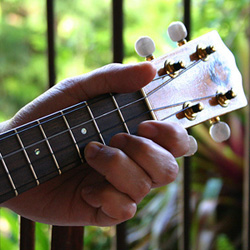
photo by Hawk3ye
You’ll have to forgive me, but I loooove talking about music theory. If we understand how music is put together, it unlocks a bunch of creative ideas for approaching songs in a different way and even writing our own songs.
So in view of our past post “Ukulele Scales Explained for Beginners” I wanted to take a look at the differences between major, minor, diminished, and augmented chords.
A Simple Explanation
When we describe a chord by major, minor, diminished, or augmented we’re referring to the quality of the chord. In their simplest form, each of these chords are three note chords known as triads. The quality of these chords or triads is determined by the intervals, or space, between each note of the triad.
Major Triads
If we recall what we learned from our explanation on scales, we can construct a major triad on the 1st, 3rd, and 5th scale degree of a major scale.

And with the chord stacked up:

Another way to think about a major triad is in terms of half steps and whole steps (see my explanation on half steps and whole steps). Between the 1st and the 3rd scale degree there are two whole steps (a major 3rd interval). Between the 3rd and 5th scale degree there is a half step and a whole step (a minor 3rd interval).
Minor Triads
If we know the major form of a chord, it’s very easy to make it into a minor chord. All we have to do is lower the 3rd degree of the chord a half step. The 1st and 5th stay the same.

This gives us a whole step and a half step between the 1st and 3rd degree (a minor 3rd interval), and two whole steps between the 3rd and 5th degree (a major 3rd interval).
Diminished Triads
Then, if we know a minor triad, we can easily make it diminished by lowering the 5th scale degree a half step. This means from a major triad, we’ve lower the 3rd and 5th scale degree both a half step.

With a diminished triad, we’ve essentially stacked two minor 3rd intervals on top of each other, because there is a whole step and a half step between the 1st and 3rd degree (a minor 3rd interval), and then, there is a whole step and half step between the 3rd and 5th degree (another minor 3rd interval).
Augmented Triads
With augmented chords, we need to go back to our major chord. An augmented chord is a major chord with the 5th degree raised a half step.

This means we have two whole steps between the 1st and 3rd degree (a major 3rd interval) and two whole steps between the 3rd and 5th degree (a major 3rd interval).
Why You Should Know This Stuff
I’ve said it before. You can get by without knowing a whole lot of theory, but theory helps you to articulate in your mind what you’re actually playing. It’s a language that allows you as a musician and artist to communicate the things you want to communicate.
On a real practical level, say you know how to play a G major chord on ukulele, but you need to know how to play a G minor chord. If you know that to make a major chord minor you only need to lower the 3rd (which in this case is a “B”) a half step, then you can find the 3rd in the chord and place your finger down a fret.
If this is confusing, post your question below. Did I miss anything you’d like to add? Let’s hear it! Be sure to check out our ukulele chord library too.

